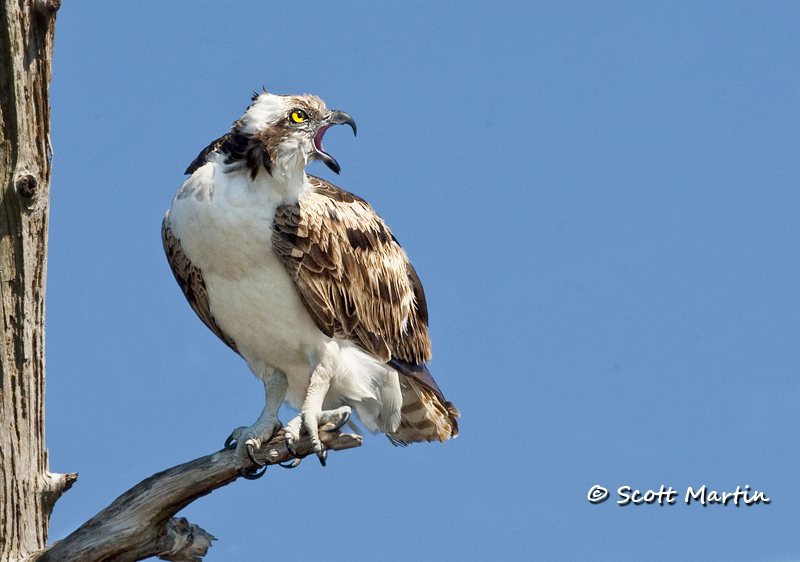
by Scott Martin Photography | Mar 27, 2011 | Birds, Blog, Raptors
We’ve just returned from eleven fabulous days in Florida where we enjoyed perfect weather, great light and now have many gigs of CF cards filled and waiting to be processed.
While in Florida our son Jeff was engaged to Ellesse and they are getting married this October. Our daughter Lindsay and her fiancé Cam are getting married this summer so we are looking forward to a fun filled and busy few months ahead.
This post will be short as I haven’t had time to process many images yet and I’m experimenting with the WordPress iPhone app to make this post, which is a first for me. Stay tuned as there are lots of upcoming posts of Florida birds.
Here is an Osprey taken at the Viera Wetlands, on the Space Coast of Florida. It’s a Mecca for bird photographers and if you have never been there you need to put it on your list of places to visit.

43.919428-78.915892
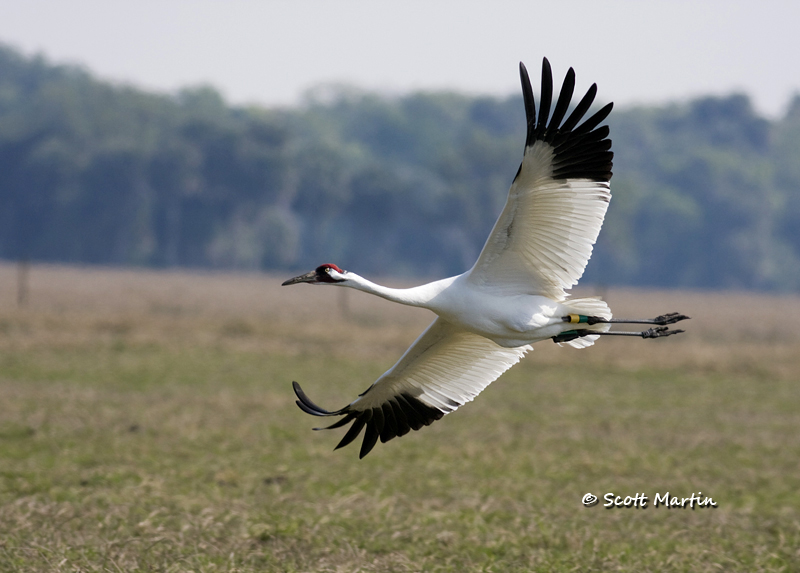
by Scott Martin Photography | Mar 3, 2011 | Birds, Blog, Raptors, Shore Birds & Waterfowl
For many years our family has joined the March Break Exodus and headed to Florida. It’s hard to believe that time of the year has arrived again! For a bird photographer March is a great time to be in Florida as many of the birds are nesting, which means they are also in their colourful breeding plumage.
Whenever you travel and are looking for birds, a great tip is to look through the yellow pages and find someone listed who makes custom bird houses and give them a call. My experience is that they will not only know where the birds are but also be willing to tell you! This is exactly what I did a few years ago and when the gentleman on the phone asked what types of birds I was looking for, my somewhat tongue-in-cheek reply was “Snail Kites and Whooping Cranes”. I was surprised when he answered “No problem, here’s exactly where you need to look”. Even more surprised were my wife and I when after driving about forty-five minutes to the location suggested we were greeted by four Whooping Cranes flying directly over top of our heads. It was an amazing sight which was followed by about an hour of watching two pairs of Whooping Cranes. After the Cranes moved on to another location we walked down to the shore line of Lake Kissimmee and within ten minutes a Snail Kite, clutching an Apple Snail flew by and offered the perfect photographic opportunity. We have gone back to the same location every year since and you guessed it, have not seen any Whooping Cranes or Snail Kites since!
Here is one of the Whooping Cranes from that day, taken hand-held with a Canon 40D and EF 400mm f/5.6 L lens.

Whooping Cranes are an endangered species and the rarest bird in North America with ~400 known wild birds. They are also North America’s tallest bird standing about six feet high with an eight foot wing span. The following image shows the relative size of the Whooping Crane….and no those are not miniature cows in the foreground 🙂
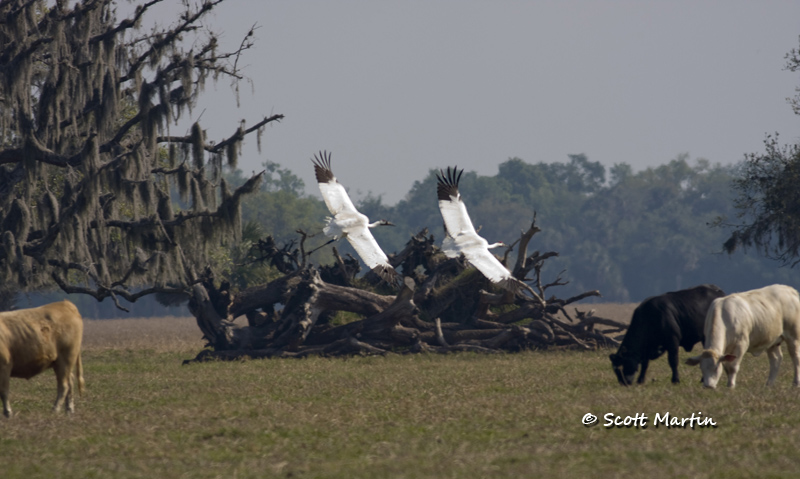
The Snail Kite is the rarest North American Raptor and is a locally endangered species in Florida where it is estimated there are about 400 breeding pairs. Their primary diet is the Apple Snail and they use their talons to deftly remove the snails from plant stems just below the water surface. They are so good at this process that they rarely get their feathers wet in the process.
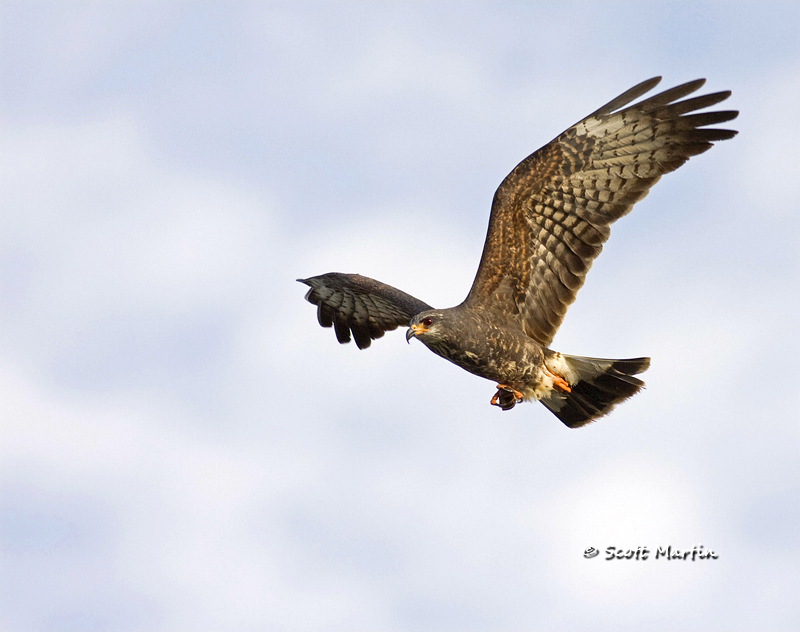
This year our goal is to photograph Snail Kites and Eagles while in Florida and who knows, perhaps even another Whooping Crane.
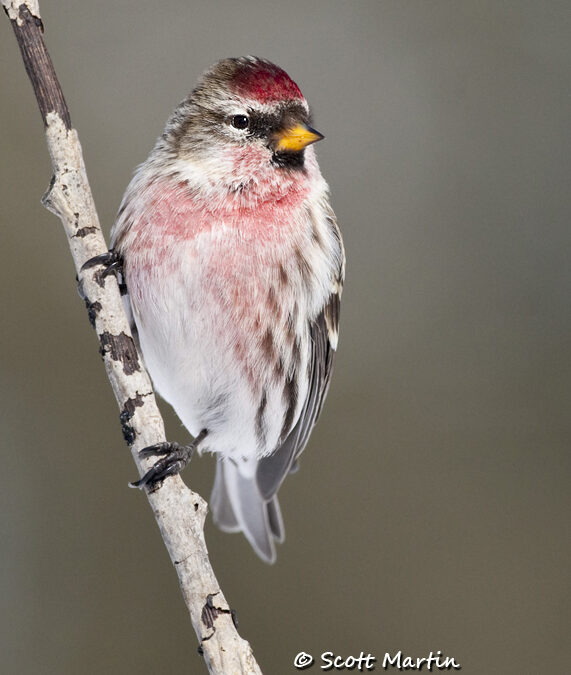
by Scott Martin Photography | Mar 1, 2011 | Birds, Blog
The winter irruption of Common Redpolls has been a welcomed surprise this year and these pretty little birds that often travel in nomadic flocks of a hundred or more have provided many great images for the photographer who has gone looking for them. They are also common in back yards that have maintained nyger seed feeders over the winter, so if you’ve been one of those fortunate people the Redpolls have come to you! Although I’ve already dedicated a blog post to the Redpolls, here are two more images that will most likely be the last until next winter.
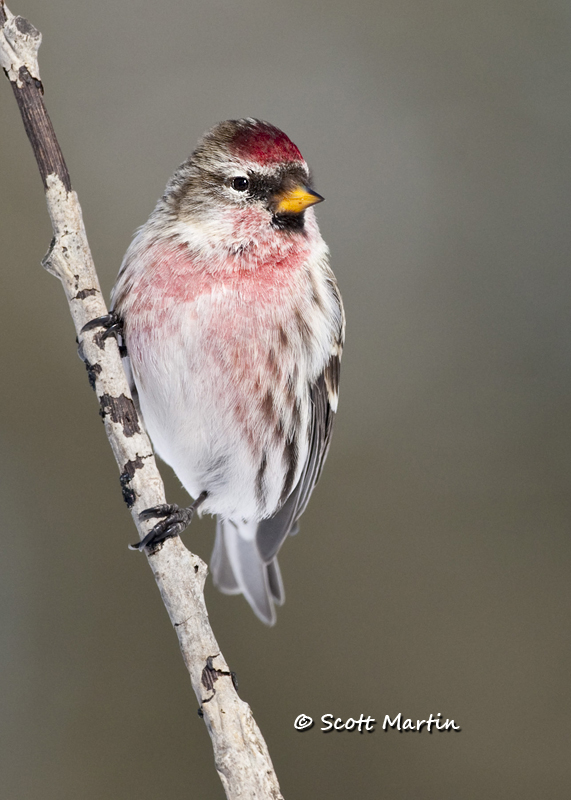
.
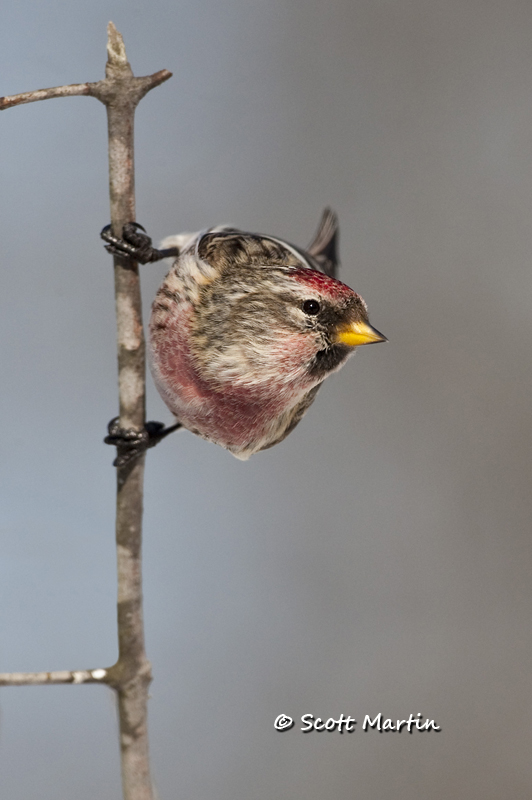
Both of the above images are of male Common Redpolls which differ from the females by their red coloured breast feathers.
The following images are from last summer however I’m just getting around to adding them to the website galleries. The first image is of a Brown Thrasher, which is a common bird that frequents thick bushes and spends much of its time on the ground (as in this image). They are a fairly skittish bird and don’t often provide great photo opportunities! The Brown Thrasher is a large bird measuring up to 30cm in length and lays its eggs in shallow nests on, or very close to the ground. This is a problem as they are prone to predation from snakes, skunks, weasels and other similar threats. The Brown Thrasher is a staunch defender of its nest and has been known to draw blood from anything, including unsuspecting birders and photographers who stray too close to an occupied nest. Perhaps what the Brown Thrasher is best known for is its wonderful and complex song. The Thrasher has the most extensive and varied vocal repertoire of any North American bird with an estimated 3,000 unique sounds they combine to form a multitude of songs and calls. In these parts of Ontario they are often heard and less frequently seen in the spring and summer months.
Click the link to hear the Brown Thrasher Call, from the Cornell Lab of Ornithology.
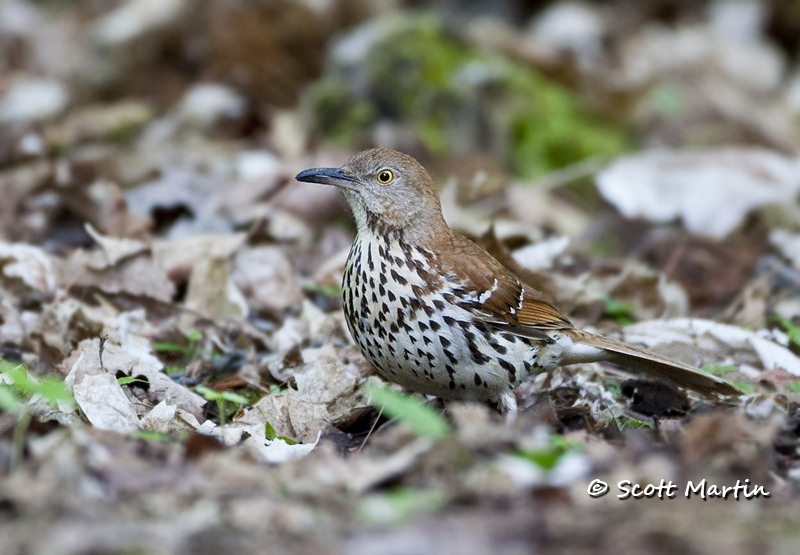
The last two images are of a Wood Thrush. Like the Brown Thrasher, Wood Thrushes prefer dense thickets and old world pine forests, such as Thickson’s Woods in Oshawa, where these images were shot. The Wood Thrush is smaller than the Thrasher, measuring about 20cm in length. Urbanization has caused the population of Wood Thrushes to be on the decline in Ontario and their reduced habitat has been largely taken over by a more common thrush, the American Robin. Like the Thrashers, Wood Thrushes have a beautiful song, which Henry David Thoreau described as the most beautiful of avian sounds.
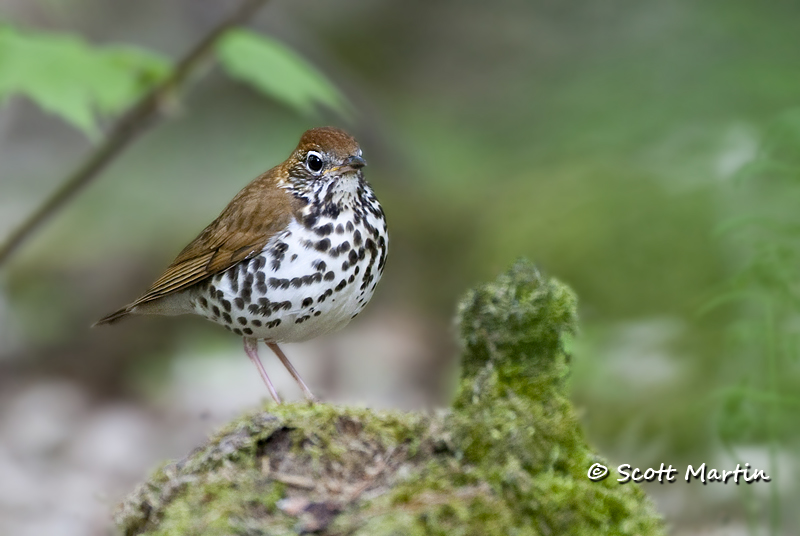
.
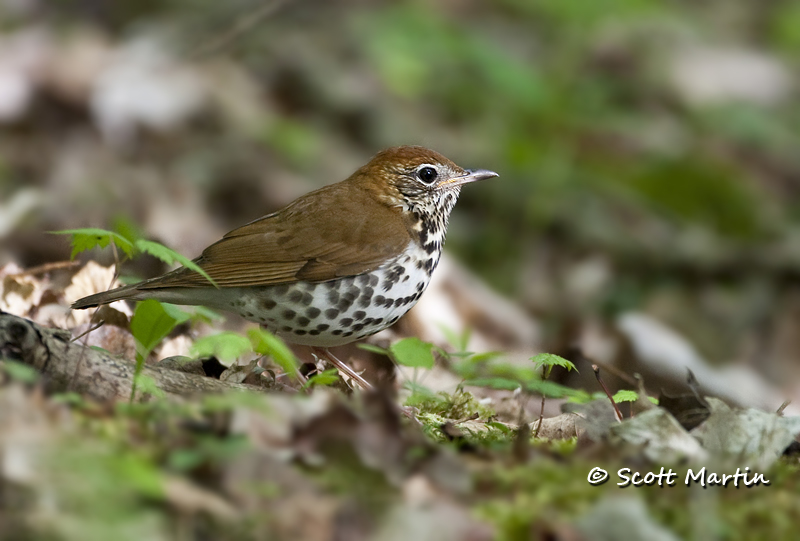
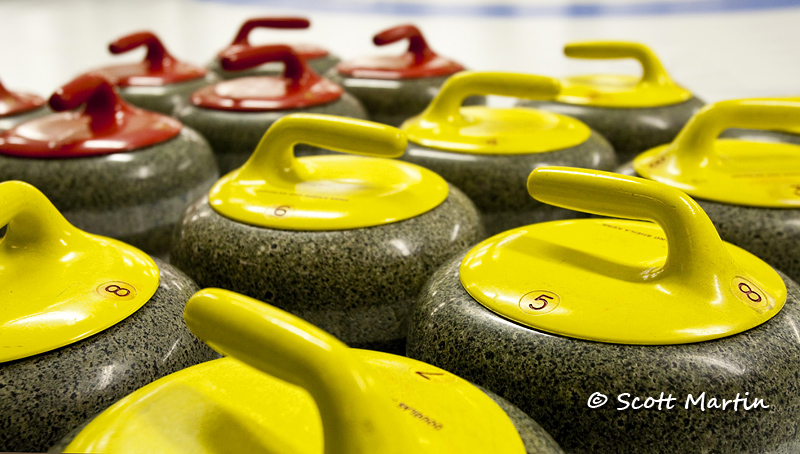
by Scott Martin Photography | Feb 23, 2011 | Blog, General
This past Saturday, my wife, son and about fifty other friends mostly from Calvary Baptist Church spent the day at the Oshawa Curling Club enjoying the great game of curling. It was a rather relaxed bonspiel with each team playing four games throughout the day with lots of time to eat and socialize between games. If you have never curled before you really should give it a try. It’s a wonderful game that’s lots of fun and couples can play together as it’s not a particularly physical game, although you can work up a sweat sweeping!
Curling, like golf, is a game with Scottish origin dating back to medieval times with the first written mention of the sport in 1541 and the first paintings depicting curling trace back to 1565 Scotland. The first curling club was founded in 1716 in Scotland and it is still active today! The Royal Montreal Curling Club is the oldest in Canada and has been operating since 1807. The Oshawa Curling Club was founded in 1882.
Curling is a rather “simple” game which involves sliding a 44 pound granite stone along about 150 feet of ice and having that rock stop as close as possible to the button which is essentially the bulls-eye of a target 12 feet in diameter. After each of the four members of the two teams playing have thrown two stones each in alternating order, the team with the rock closest to the button gets a point for each stone that is closer to the button than any of the other team’s stones.
Curling Stones have changed greatly over the years from flat river stones to the high-tech $650.00, forty four pound hunks of granite they are today. The Canadian Curling Stone Company is a world-wide leader in curling stone manufacturing with most of the stones used in world-class bonspiels coming from the Canadian company.

The brooms used for sweeping the rocks down the ice, to help control the distance & curl of the rock, have also changed a lot over the years, from the old corn brooms of the past to the synthetic brushless brooms used today. In fact the “brooms” used today are actually brushes, but you will never hear hem referred to as anything but brooms.
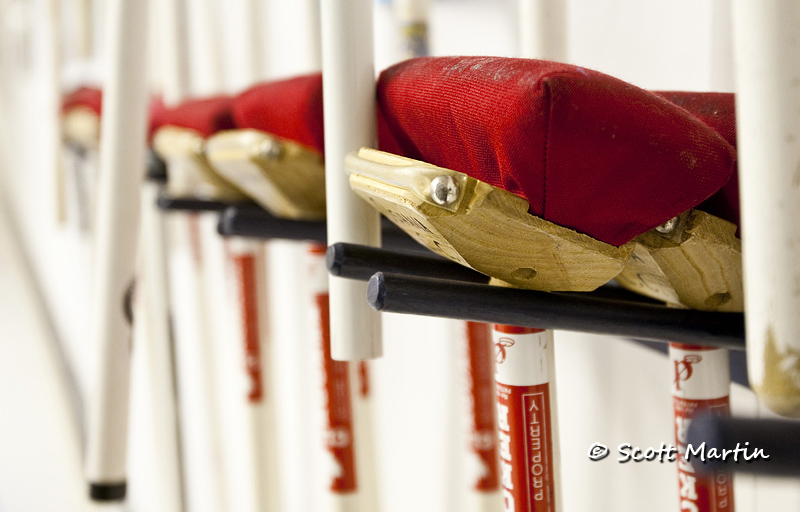
Although curling predated the invention of indoor curling rinks, virtually 100% of curling matches now take place inside a curling rink where the ice conditions are perfect. Here is an inside view of the Oshawa Curling Club which has been in operation since 1882 and has hosted several national & international bonspiels over its many years of operation.


As this is a photography blog please take time to notice the difference between the two quite similar images above. The first is from a higher angle of view using a small aperture to create more depth of field (keeping everything in focus) and making the curling rink the object of the image. The second image has a much lower angle of view and larger aperture to create a very shallow depth of field. Although the composition of the two is similar the object of the second clearly becomes the curling stones. Whenever you are out shooting, remember to shoot the same scene from different angles of view and at differing apertures. Differing angles of view and apertures can make similarly composed images look completely different from each other.
To end this post, here are a few shots of curlers pushing off the hack and delivering the stone down the sheet of ice presumably to stop on the button. These images were all taken with a Canon 1D MkIII and 70-200 f/2.8 IS lens. I believe the following images were all taken at f/2.8 to create a shallow depth of field, blurring the distracting back ground elements that are often found when in an indoor setting. The problem with shooting at f/2.8 is that the depth of field is so shallow it is hard to get all of the person in perfect focus. This problem is minimized by using the AI Servo focusing mode which tracks the object in the viewfinder and continuously adjusts the focus to keep the object sharp.

.

.

.

.
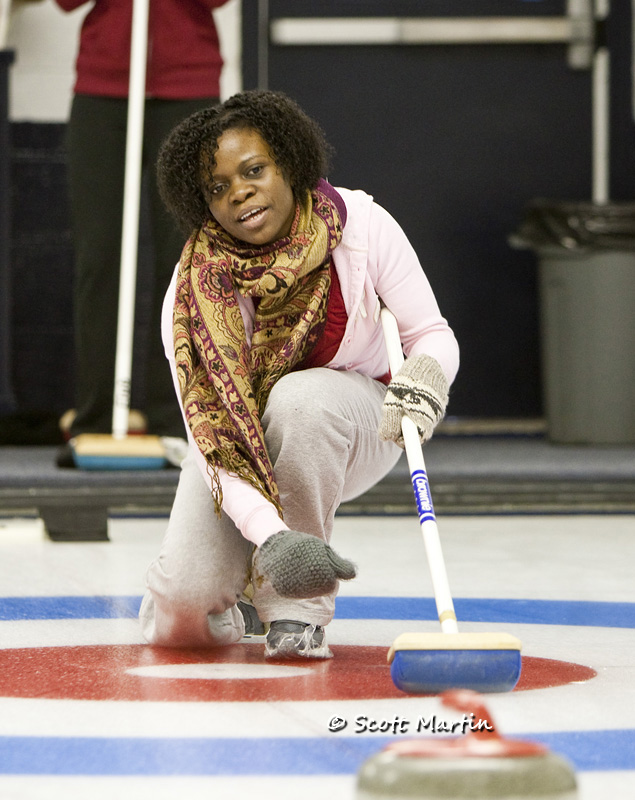
.

.

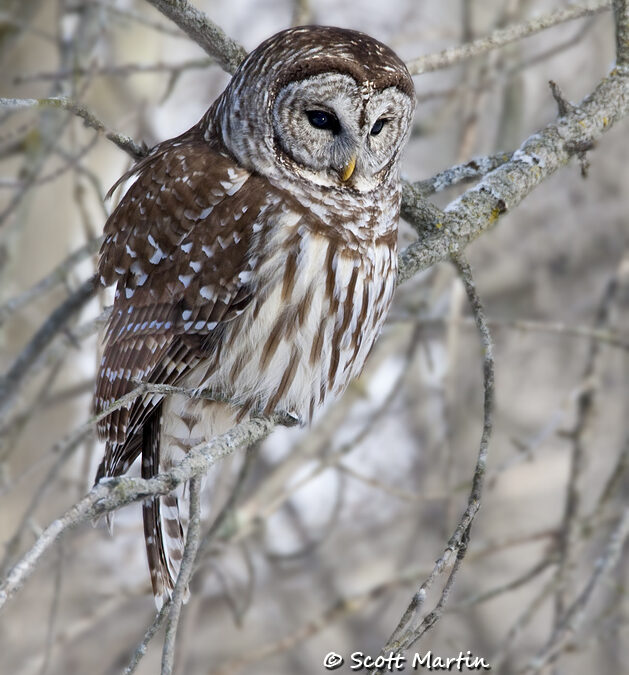
by Scott Martin Photography | Feb 18, 2011 | Birds, Blog, Raptors
Of the eleven different Owl species that are seen in Ontario, the Barred Owl is probably my favourite for any number of reasons; they are somewhat active during the day, they move around regularly providing opportunities to see them in flight, they can be very noisy and provide lots of interesting sounds, and they are photogenic.
Barred Owls have very dark eyes (unlike any other North American Owl save the Barn Owl) and are a large bird up to 62 cm in length and a wingspan of 1-1.3 metres making the larger than a Red Tailed Hawk with a wingspan greater than a crow. Barred Owls have fairly weak talons and therefore prey on smaller animals such as mice, voles and squirrels although they will also eat small amphibians and birds as well. Barred Owls nest in natural tree cavities where the female lays 2-3 eggs requiring about thirty days to incubate. The female remains on the eggs for all of the incubation period and the male brings her food.
Although the Barred Owl is one of the more popular Ontario Owls they are still uncommon and their numbers in Southern Ontario are on the decline as urbanization destroys the deciduous woodland environment they require to thrive.
We are fortunate to have a Barred Owl pair not too far from home and it was a pleasure for my friend Don & I to spend a while with one of them this past Saturday morning. At one point as the Owl relocated to another hunting area he flew just above eye level within about twenty feet of us which was amazing to see. They are virtually silent in flight and maneuver effortlessly through the dense forest cover for such a large bird.
The following images were taken at 700mm (500/4 + 1.4x TC) using a mono-pod for support.
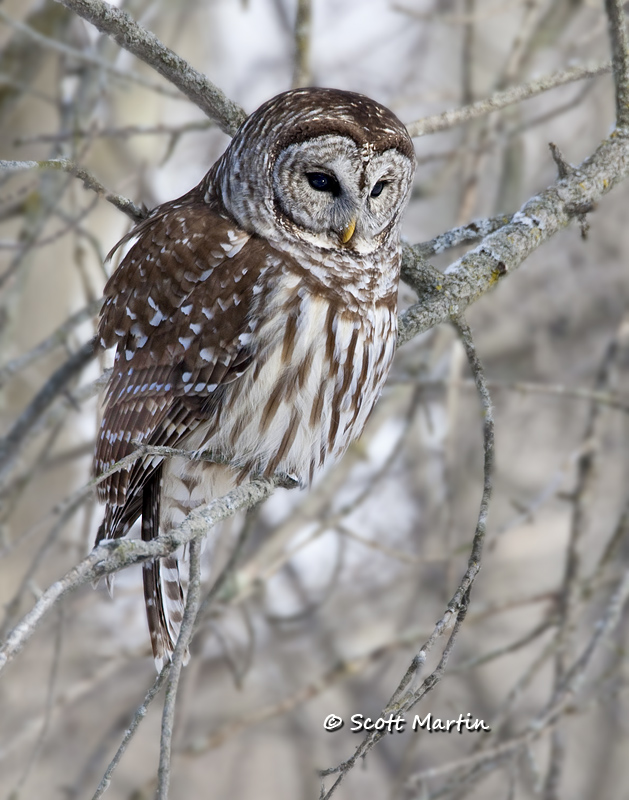
.
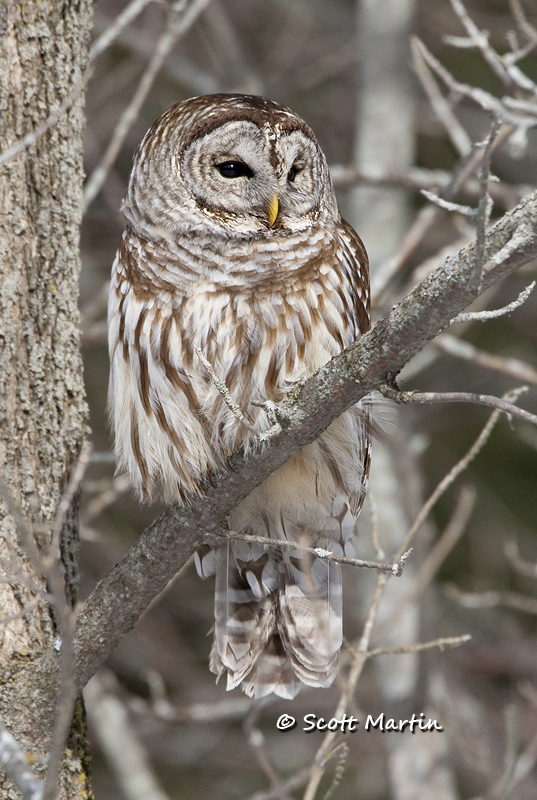
.
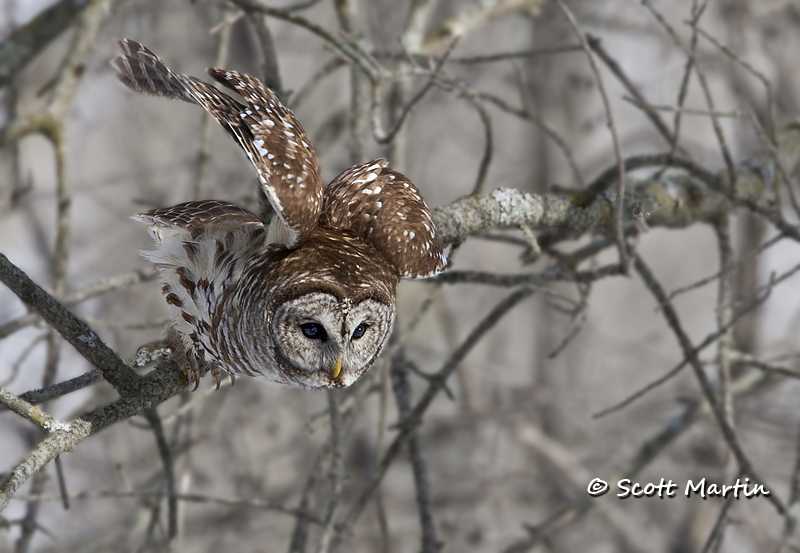
More Owls can be viewed by clicking the Owls Gallery. Please feel free to leave a comment as they are always appreciated, as are Tweets to your followers if you are so inclined….. just click the little icon below 🙂
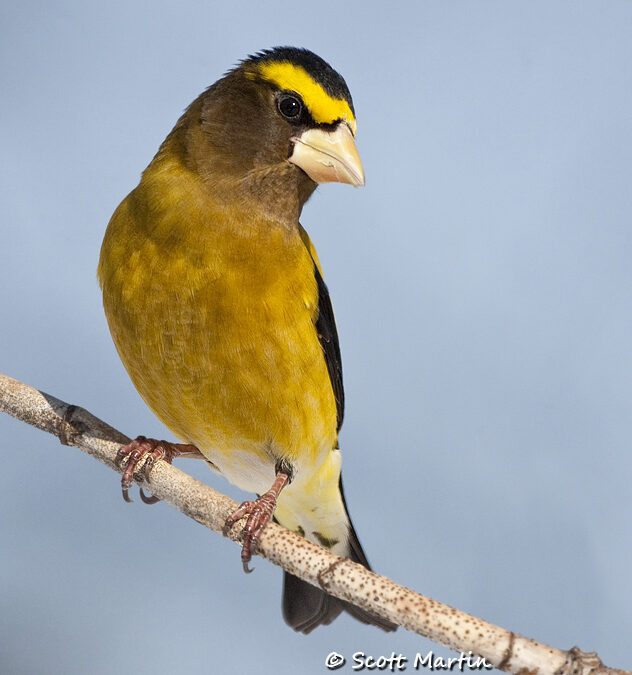
by Scott Martin Photography | Feb 17, 2011 | Birds, Blog, Raptors, Sparrows
After making a most enjoyable return trip to the Kawartha Lakes Region of Ontario, I was able to get some acceptable images of male Evening Grosbeaks. The bright white secondary wing feathers on males creates a photographic challenge as the tendency is to over expose the whites removing all detail and commonly referred to as “blowing out the whites”. Blown whites are a huge faux pas in photography however avoiding them completely is often very difficult if not impossible. They occur very easily when shooting birds with contrasting dark & light colours, such as Black Capped Chickadees, Buffle Head Ducks or in this case Evening Grosbeaks. The methods used to lessen the likelihood of blowing out the whites are many however they all involve underexposing the recommendations from what the camera meter is suggesting (unless you are able to spot meter on the whites alone in the viewfinder). Creating an image with the whites properly exposed darkens the shadows and typically underexposes the rest of the scene, however this can be accommodated for quite easily in post processing, especially if you are shooting in RAW. Remember you can always get more detail back from the shadows & underexposed areas of an image but once you blow the whites you can never reclaim any detail with Photoshop.
Here are some male Evening Grosbeaks
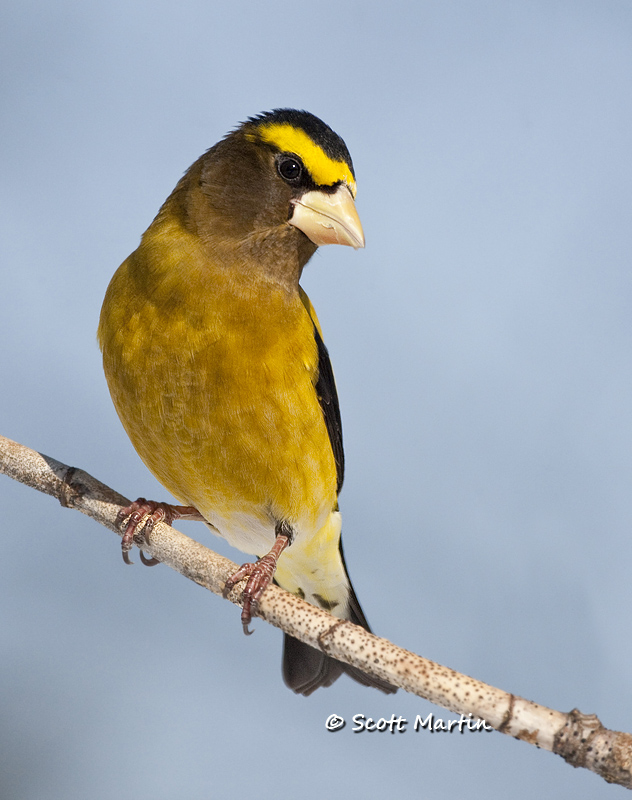
.
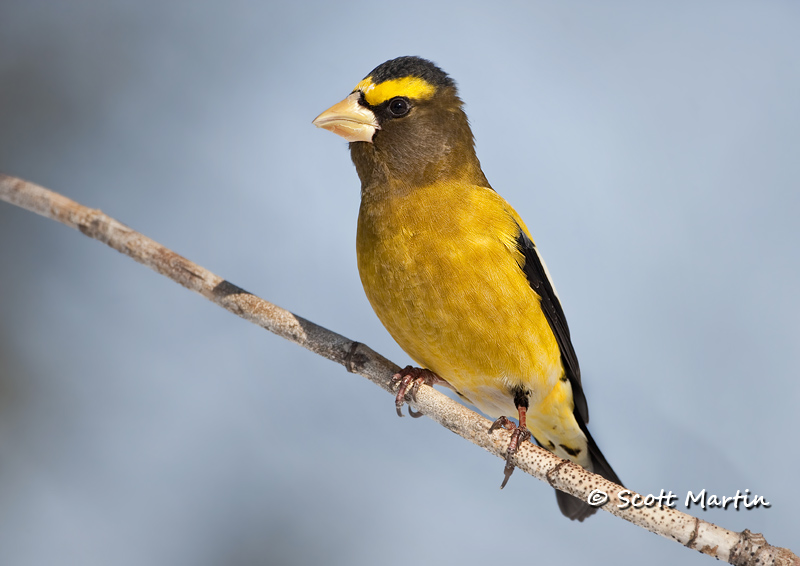
.

…..and finally another female.

Click on the Evening Grosbeaks Blog to learn more about Evening Grosbeaks and on the Grosbeaks Gallery to see more images.
On an unrelated and unfortunate note, it was reported on Valentine’s Day, that a Northern Hawk Owl wintering in the Kawartha Lakes Region was struck and killed by passing car while the owl was hunting for food. Bob Bowles, noted Orillia Naturalist, provided the following report:
“The Northern Hawk Owl that was found during our Carden Alvar CBC on January 2, 2011 has been hunting in the wetland near the junction of Road 46 from Simcoe and Road 6 from City Of Kawartha Lakes. Several birders have reported this bird this winter during the month of January and into February. This morning it was found dead on the side of the road between Avery Point Road and the junction where is was first reported. It had a Meadow Vole clutched in its right talon and had a broken left wing. We can only assume that it was hit by a passing vehicle as it hunted along the roadway.
For the last three years, a Northern Hawk Owl has been observed during winter each year just after Christmas in most cases near Orillia. All have ended up the same way being found dead after being hit by a passing vehicle. This bird had been observed a few weeks ago hunting near the road and flying low over the road barely being missed by passing cars. I was hoping that this one would make it through the winter to return north in the spring but it didn’t make it”.
Here is a shot of the Northern Hawk Owl taken last month while it perched in a tree alongside County Road 46. Others can be seen in the Owl Gallery
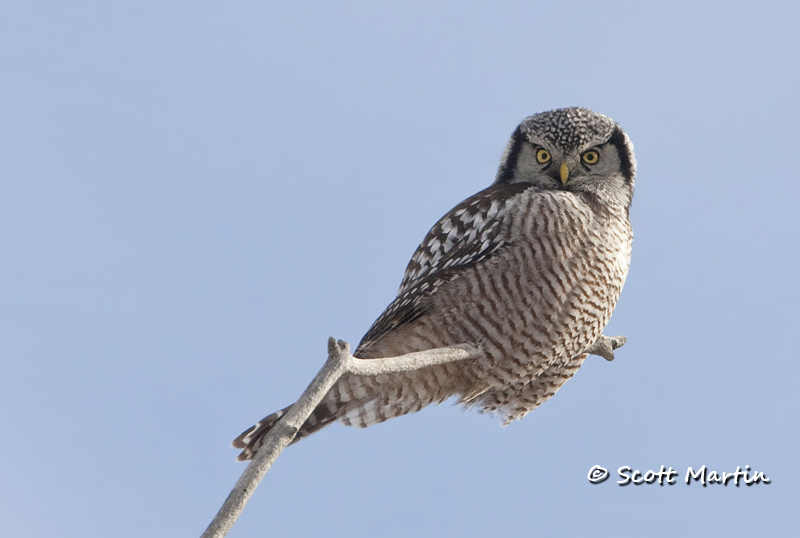



































Follow Scott Martin Photography